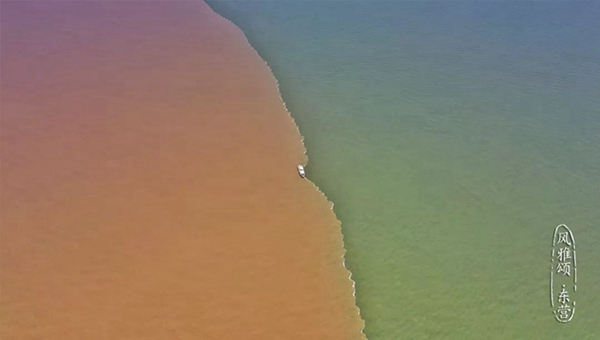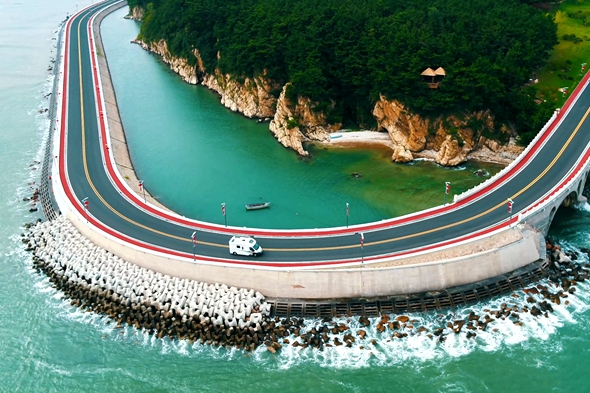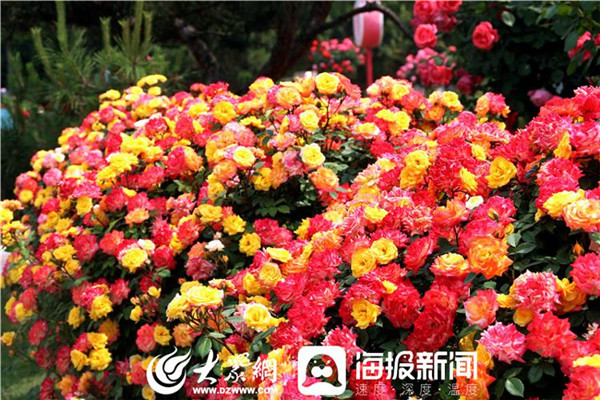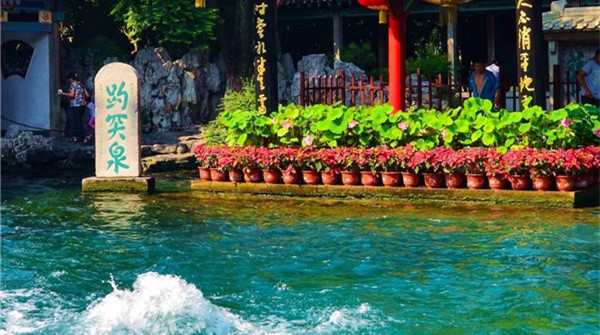Shandong works on building Yellow River Cultural Tourism Belt
Shandong province has made a Yellow River culture protection, inheritance, and promotion plan to accelerate its construction of the Yellow River Cultural Tourism Belt, according to the Shandong Provincial Department of Culture and Tourism on May 30.
A strategy of building an axis, two belts, and nine clusters was proposed in the plan, which aims to realize resources transfer through new industries, stimulate consumption through integrated industries, as well as promote the high-quality development of the Yellow River culture and tourism sectors.
The axis features the integrated development of the culture and tourism sectors along the main stream of the Yellow River, running across four areas, including the river's course to the sea, its course to the city, the ancient Yellow River, and its course to Shandong.

An aerial view shows the clear boundary in the fair weather between the colors of deep blue and yellow where the Yellow River joins the Bohai Sea in the Yellow River Estuary Ecotourism Area in Dongying, Shandong province. [Photo/WeChat account: Dongying Weekly]
The two belts include a Qilu excellent traditional culture entrepreneurship and innovation demonstration belt featuring three traditional culture highlands called Zoulu, Taiwen, and Qingqi, as well as a Yellow River ancient riverbed eco-culture coordinated development belt that runs across two eco-cultural clusters named Jiuhe ancient riverbed and Weishan Lake.
Field trips to cities and counties along the Yellow River have been launched to gain a better understanding of the river's ecological and cultural resources, as well as to roll out targeted protection measures and development strategies in an effort to lay a solid foundation for the construction of the Yellow River Cultural Tourism Belt.
Shandong is also focusing on the protective development of cultural relics. The Yellow River Cultural Tourism Belt is built on the premise of resources protection and ecological improvement.
According to statistics, there are six national historic and cultural cities, six provincial-level historic and cultural cities, 150 important heritage sites under state protection, 1,087 important heritage sites under provincial protection, 107 national intangible cultural heritage items, as well as 449 provincial-level intangible cultural heritage items in regions along the Yellow River in Shandong.
There are also 622 A-rated scenic spots, accounting for half of the province's total, including four 5A-rated ones and 102 4A-rated ones. The regions also have 13 tourist resorts, eight national all-for-one tourism demonstration areas, and 13 provincial-level all-for-one tourism demonstration areas.
Five recreational belts around metropolises, eight countries with cluster development, as well as a number of villages and towns with cluster development have been formed. All of these resources have laid a solid industrial foundation for the protection, inheritance, and promotion of the Yellow River culture.
Nearly 200 Yellow River cultural tourism-featured projects have been planned in the province, some of which have been completed, some are under construction, and some are about to be built. The completed projects include the Nishan Sacredland in Qufu of Jining, Xiajin Debai Tourist Town in Dezhou, and Huimin Xincheng Tourist Town in Binzhou.
The government has given 29.62 million yuan ($4.63 million) in financial support to 15 key cultural and tourist projects, which attracted investment of nearly 11 billion yuan. A database of key Yellow River cultural tourism projects was also built, with a planned total investment of over 570 billion yuan.
In order to promote the integrated development of industries, the province is working on combining the Yellow River cultural tourism industry with development strategies, such as ecological civilization construction, new and old kinetic energy conversion, as well as rural revitalization.
It also promotes cultural integration by combing Yellow River culture with Confucianism, Qi culture, Mount Tai culture, ocean culture, red culture, as well as modern culture. It also uses intangible cultural heritage resources to build scenic spots and commercial areas that feature creative culture.
Moreover, Shandong is making use of its own strengths to build landscape corridors and nurture Yellow River cultural brands. It is improving transportation facilities along the Yellow River main stream to establish high-standard landscape routes, optimize landscape design and tourist signs to improve the quality of the environment, as well as build a self-driving tour corridor supported by characteristic courier stations.
As a result, a Yellow River cultural tourism belt will be formed, backed by the tourist brand of Yellow River Entering the Sea, a self-driving landscape corridor, important tourist cities, scenic spots, rural tourism spots, as well as cultural heritage sites along the Yellow River.

 Nishan Forum on World Civilizations
Nishan Forum on World Civilizations Explore magnificent Yellow River culture in Shandong
Explore magnificent Yellow River culture in Shandong

